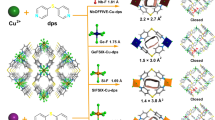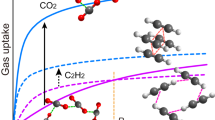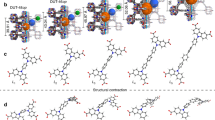Abstract
Mesoporous materials with tunable non-oxidic framework compositions can exhibit new kinds of functionality including internal surfaces with high polarizability. As the chemical and physical characteristics of the framework components can induce useful catalytic, absorption and optoelectronic features, the mesoporous structure can promote fast mass diffusion kinetics and size-selective transport of guest molecules1. So far, synthetic efforts have resulted in mesoporous metal chalcogenides on using structure-directing moulds of soft or hard templates. These include ordered mesoporous II–VI semiconductors (such as CdS (refs 2,3), ZnS (ref. 4) and CdTe (ref. 5)). Recently, template-free synthetic routes for high-surface-area chalcogenide aerogels have been reported6,7. Here, we describe a novel kind of porous materials based on germanium-rich chalcogenide networks and ‘soft’ highly polarizable surfaces. We demonstrate that these materials can exhibit excellent selectivity for separating hydrogen from carbon dioxide and methane. These highly polarizable mesoporous structures have important implications for membrane-based gas separation process technologies including hydrogen purification.
This is a preview of subscription content, access via your institution
Access options
Subscribe to this journal
Receive 12 print issues and online access
$259.00 per year
only $21.58 per issue
Buy this article
- Purchase on Springer Link
- Instant access to full article PDF
Prices may be subject to local taxes which are calculated during checkout




Similar content being viewed by others
References
Antonietti, M. & Ozin, G. A. Promises and problems of mesoscale materials chemistry or why meso? Chem. Eur. J. 10, 28–41 (2004).
Braun, P. V., Osenar, P. & Stupp, S. I. Semiconducting superlattices templated by molecular assemblies. Nature 380, 325–328 (1996).
Gao, F., Lu, Q. & Zhao, D. Synthesis of crystalline mesoporous CdS semiconductor nanoarrays through a mesoporous SBA-15 silica template technique. Adv. Mater. 15, 739–742 (2003).
Li, J., Kessler, H., Soulard, M., Khouchaf, L. & Tuiler, M.-H. Nanosized zinc sulfide obtained in the presence of cationic surfactants. Adv. Mater. 10, 946–949 (1998).
Jiang, T. & Ozin, G. A. New directions in tin sulfide materials chemistry. J. Mater. Chem. 8, 1099–1108 (1998).
Mohanan, J. L., Arachchige, I. U. & Brock, S. L. Porous semiconductor chalcogenide aerogels. Science 307, 397–400 (2005).
Bag, S., Trikalitis, P. N., Chupas, P. J., Armatas, G. S. & Kanatzidis, M. G. Porous semiconducting gels and aerogels from chalcogenide clusters. Science 317, 490–493 (2007).
MacLachlan, M. J., Coombs, N. & Ozin, G. A. Non-aqueous supramolecular assembly of mesostructured metal germanium sulphides from (Ge4S10)4− clusters. Nature 397, 681–684 (1999).
Trikalitis, P. N., Rangan, K. K., Bakas, T. & Kanatzidis, M. G. Varied pore organization in mesostructured semiconductors based on the [SnSe4]4− anion. Nature 410, 671–675 (2001).
Rangan, K. K. et al. Hexagonal pore organization in mesostructured metal tin sulfides built with [Sn2S6]4− cluster. Nano Lett. 2, 513–517 (2002).
Fröba, M. & Oberender, N. First synthesis of mesostructured thiogermanates. Chem. Commun. 1729–1730 (1997).
Armatas, G. S. & Kanatzidis, M. G. Mesostructured germanium with cubic pore symmetry. Nature 441, 1122–1125 (2006).
Armatas, G. S. & Kanatzidis, M. G. Hexagonal mesoporous germanium. Science 313, 817–820 (2006).
Sun, D. et al. Hexagonal mesoporous germanium through surfactant-driven self-assembly of Zintl clusters. Nature 441, 1126–1130 (2006).
Armatas, G. S. & Kanatzidis, M. G. Mesoporous compound semiconductors from metal-linked deltahedral Ge9 clusters. J. Am. Chem. Soc. 130, 11430–11436 (2008).
Rouquerol, F., Rouquerol, J. & Sing, K. S. W. Adsorption by Powders and Porous Solids. Principles Methodology and Applications (Academic, 1999).
Foix, D., Gonbeau, D., Granier, D., Pradel, A. & Ribes, M. Electronic structure of thiogermanate and thioarseniate glasses: Experimental (XPS) and theoretical (ab initio) characterizations. Solid State Ion. 154-155, 161–173 (2002).
Ueno, T. X-ray photoelectron and Anger electron spectroscopic studies of chemical shifts in amorphous Ge–Se system. Japan. J. Appl. Phys. 22, 1349–1352 (1983).
Yashina, L. V., Kobeleva, S. P., Shatalova, T. B., Zlomanov, V. P. & Shtanov, V. I. XPS study of fresh and oxidized GeTe and (Ge,Sn)Te surface. Solid State Ion. 141/142, 513–522 (2001).
Oh, J. & Campbell, J. C. Thermal desorption of Ge native oxides and the loss of Ge from the surface. J. Electron. Mater. 33, 364–367 (2004).
Yang, R. T. Adsorbents: Fundamentals and Applications Ch. 2 (Wiley, 2003).
Garcia, L., French, R., Czernik, S. & Chornet, E. Catalytic steam reforming of bio-oils for the production of hydrogen: Effects of catalyst composition. Appl. Catal. A 201, 225–239 (2000).
Schlapbach, L. & Züttel, A. Hydrogen-storage materials for mobile applications. Nature 414, 353–358 (2001).
Myers, A. L. & Prausnitz, J. M. Thermodynamics of mixed-gas adsorption. AIChEJ. 11, 121–127 (1965).
Lin, H., Wagner, E. V., Freeman, B. D., Toy, L. G. & Gupta, R. P. Plasticization-enhanced hydrogen purification using polymeric membranes. Science 311, 639–642 (2006).
Verweij, H., Lin, Y. S. & Dong, J. Microporous silica and zeolite membranes for hydrogen purification. MRS Bull. 31, 756–764 (2006).
Ockwig, N. W. & Nenoff, T. M. Membranes for hydrogen separation. Chem. Rev. 107, 4078–4110 (2007).
Verweij, H., Lin, Y. S. & Dong, J. Microporous silica and zeolite membranes for hydrogen purification. MRS Bull. 31, 756–764 (2006).
Wang, K. & Stiefel, E. I. Toward separation and purification of olefins using dithiolene complexes: An electrochemical approach. Science 291, 106–109 (2001).
Broxon, T. J. & Chung, R.P.-T. Micellar bound Meisenheimer complexes. J. Org. Chem. 55, 3886–3890 (1990).
Acknowledgements
These studies were supported primarily by the Nanoscale Science and Engineering Initiative of the National Science Foundation under NSF Award Number EEC-0647560. We thank Peter C. Stair for the use of a mass-spectrometer gas analyser. This work made use of the J.B. Cohen X-ray Diffraction facility and the Electron Probe Instrumentation Center (EPIC) and Keck Interdisciplinary Surface Science (Keck-II) facility of NUANCE Center at Northwestern University.
Author information
Authors and Affiliations
Corresponding authors
Supplementary information
Supplementary Information
Supplementary Information (PDF 1574 kb)
Rights and permissions
About this article
Cite this article
Armatas, G., Kanatzidis, M. Mesoporous germanium-rich chalcogenido frameworks with highly polarizable surfaces and relevance to gas separation. Nature Mater 8, 217–222 (2009). https://doi.org/10.1038/nmat2381
Received:
Accepted:
Published:
Issue Date:
DOI: https://doi.org/10.1038/nmat2381
This article is cited by
-
Bottom-up synthesis of high surface area mesoporous crystalline silicon and evaluation of its hydrogen evolution performance
Nature Communications (2014)
-
Solvothermal syntheses and crystal structures of two new thiogermanates [M(dap)3]4Ge4S10Cl4 (M = Co, Ni) with metal complexes as counterions
Monatshefte für Chemie - Chemical Monthly (2011)



